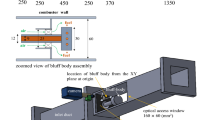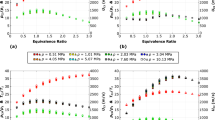Abstract
Special flame merging behaviour and complex combustion characteristics can be formed under the coupling effect of tangential flow and heat transfer of multiple pool fires (MPFs) in a shaft. In this study, quadruple pool fires (DPFs) evolutionary experiments in shaft were carried out, and the influence of pooled spacing and side slit width of the shaft on flame merging behaviour were analyzed. The primary influencing mechanism of merged flame evolution was expounded from heat transfer and thermal feedback between fire sources. The shape of conical merged fire whirls that can completely fill the gap between the oil pools with flame is confirmed, and its cone angle is determined by the position of outer edge of oil pools. In the formation of merged fire whirls, the critical conditions are that the distance between fire sources is less than three times the pool diameter and the width of side slits is 1/4 of the side length of the shaft, respectively. Compared with the single pool fire whirls with the same liquid surface area, the thermal flow field of DPFs in shaft is relatively unfavorable to the formation of fire whirls. The formation time of merged fire whirls is nearly five times that of the single pool fire whirls, and the flame height can be reduced by nearly half.
The evolution process of the DPFs that can form merged fire whirls exhibits the multi-stage morphological characteristics over time and all of these stages possess different heat transfer mechanisms. Before forming the merged fire whirls, intermittent merging among pool fires is a necessary stage. And the duration of this stage is relatively less affected by the width of slit on the side of shaft. The transverse force of asymmetric tangential flow on the flame is difficult to be completely overcomed by merged fire whirls. Because of the inclination of merged flame, the overall vertical height is unsuitable as a direct characterization parameter of combustion intensity.























Similar content being viewed by others
Data availability
The data that support the findings of this study are available from the corresponding author, upon reasonable request.
References
Liu Q (2010) Dynamical mechanism and behaviors of multiple fires burning. University of Science and Technology of China, A dissertation for doctor’s degree (In Chinese)
Vansanth S, Tauseef SM, Tasneem A, Abbasi SA (2014) Multiple pool fires: Occurrence, simulation, modeling and management. J Loss Prev Process Ind 29:103–121
Putnam AA, Speich CF (1963) A model study of the interaction of multiple turbulent diffusion flames. Symp Combust 9(1):867–877
Jiao Y, Gao W, Liu NA, Lei J, Xie XD, Zhang LH, Tu R (2019) Interpretation on fire interaction mechanisms of multiple pool fires. Proc Combust Inst 37:3967–3974
Wan H, Ji J, Li K, Huang X, Sun J, Zhang Y (2017) Effect of air entrainment on the height of buoyant turbulent diffusion flames for two fires in open space. Proc Combust Inst 36(2):3003–3010
Yu LX, Wan HX, Gao ZH, Ji J (2021) Study on flame merging behavior and air entrainment restriction of multiple fires. Energy 218:119470
Vasanth S, Tauseef SM, Abbasi T, Rangwala AS, Abbasi SA (2014) Assessment of the effect of pool size on burning rates of multiple pool fires using CFD. J Loss Prev Process Ind 30(1):86–94
Baldwin R (1968) Flame merging in multiple fires. Combust Flam 12(4):318–324
Chen YH, Zhang XL, Miao YL, Hu LH (2022) Effects of cross airflow and burner distance on temperature profile and flame morphology of dual tandem pool fires. Fuel 317:123220
Chen Z, Wei XL, Li T (2021) Experimental Investigation on Flame Characterization and Temperature Profile of Single/Multiple Pool Fire in Cross Wind. J Therm Sci 30(1):324–332
Liu NA, Liu Q, Deng Z, Satoh K, Zhu J (2007) Burn-out time data analysis on interaction effects among multiple fires in fire arrays. Proc Combust Inst 31:2589–2597
Liu NA, Liu Q, Lozano JS, Shu LF, Zhang LH, Zhu JP, Deng ZH, Satho K (2009) Global burning rate of square fire arrays: Experimental correlation and interpretation. Proc Combust Inst 32(2):2519–2526
Liu NA, Liu Q, Lozano JS, Zhang LH, Deng ZH, Yao B, Zhu JP, Satoh K (2013) Multiple fire interactions: A further investigation by burning rate data of square fire arrays. Proc Combust Inst 34(2):2555–2564
Li Z, Liu NA (2012) Experimental study on combustion characteristics of multiple heptane pool fires. Fire Safety Science 21(3):109–116 (In Chinese)
Weng WG, Kamikawa D, Fukuda Y, Hasemi Y, Kagiya K (2004) Study on flame height of merged flame from multiple fire sources. Combust Sci Technol 176(12):2105–2123
Huffman KG, Welker JR, Sliepcevich CM (1969) Interaction effects of multiple pool fires. Fire Technol 5(3):225–232
Sugawa O, Takahashi W (1993) Flame height behavior from multi-fire sources. Fire Mater 17(3):111–117
Ji J, Wan HX, Gao ZH, Fu YY, Sun JH, Zhang YM, Li KY, Hostikka S (2016) Experimental study on flame merging behaviors from two pool fires along the longitudinal centerline of model tunnel with natural ventilation. Combust Flame 173:307–318
Delichatsios MA (2007) A Correlation for the Flame Height in ‘Group’ Fires. Fire Sci Technol 26(1):1–8
Thomas PH, Baldwin R, Heselden AJM (1965) Buoyant diffusion flames: some measurements of air entrainment, heat transfer, and flame merging. Symp Combust 10(1):983–996
Kamikawa D, Weng WG, Kagiya K, Fukuda Y, Mase R, Hasemi Y (2005) Experimental study of merged flames from multifire sources in propane and wood crib burners. Combust Flame 142:17–23
Weng W, Kamikawa D, Hasemi Y (2015) Experimental study on merged flame characteristics from multifire sources with wood cribs. Proc Combust Ins 35(3):2597–2606
Oka Y, Imazeki O, Sugawa O (2010) Temperature profile of ceiling jet flow along an inclined unconfined ceiling. Fire Saf J 45(4):221–227
Sugawa O, Kawagoe K, Oka Y, Takahashi K (1990) Experimental study on extended flame behavior from an opening using a full scale and a reduced scale model. American Society of Mechanical Engineers, Heat Transfer Division, (Publication) HTD, 141:71–76
Sugawa O, Oka Y (2003) Experimental study on flame merging behavior from 2 by 3 configuration model fire sources. Fire Saf Sci 7:891–902
Lei J, Liu NA (2016) Reciprocal transitions between buoyant diffusion flame and fire whirl. Combust Flam 167:463–471
Zukoski EE, Kubota T, Cetegen B (1981) Entrainment in fire plumes. Fire Saf J 3(3):107–121
Lei J (2012) Experimental and theoretical researches on the combustion dynamics of fire whirls. University of Science and Technology of China, A dissertation for doctor’s degree: 17–122 (In Chinese)
Zhou KB (2013) Combustion behaviors and flame-moving mechanism of fire whirls. University of Science and Technology of China, A dissertation for doctor’s degree: 19–48 (In Chinese)
Acknowledgements
This study was supported by the National Natural Science Foundation of China (NSFC Nos. 51976041 and 51676051) and the Fundamental Research Funds for the Central Universities (No. 3072022CF0210), for which the authors express their gratitude.
Author information
Authors and Affiliations
Corresponding authors
Ethics declarations
Conflict of interest
The authors declare that they have no known competing financial interests or personal relationships that could have appeared to in influence the work reported in this paper.
Additional information
Publisher's Note
Springer Nature remains neutral with regard to jurisdictional claims in published maps and institutional affiliations.
Highlights
• The cone angle of the conical merged fire whirls is determined by the position of the outer boundary of the oil pools.
• Intermittent merging among pool fires is a necessary stage before forming the merged fire whirls.
• The transverse force of asymmetric tangential flow on the flame is difficult to be completely overcome by the merged fire whirls.
• The width of the side slits of the shaft mainly affects the non-merged and continuous merged flame stages.
Rights and permissions
Springer Nature or its licensor (e.g. a society or other partner) holds exclusive rights to this article under a publishing agreement with the author(s) or other rightsholder(s); author self-archiving of the accepted manuscript version of this article is solely governed by the terms of such publishing agreement and applicable law.
About this article
Cite this article
Huo, Y., Yu, YP., Yang, Dm. et al. Experimental study on the dynamic evolution of merged flame under the thermal effect of multiple fire sources in a shaft. Heat Mass Transfer 59, 2197–2211 (2023). https://doi.org/10.1007/s00231-023-03405-4
Received:
Accepted:
Published:
Issue Date:
DOI: https://doi.org/10.1007/s00231-023-03405-4




